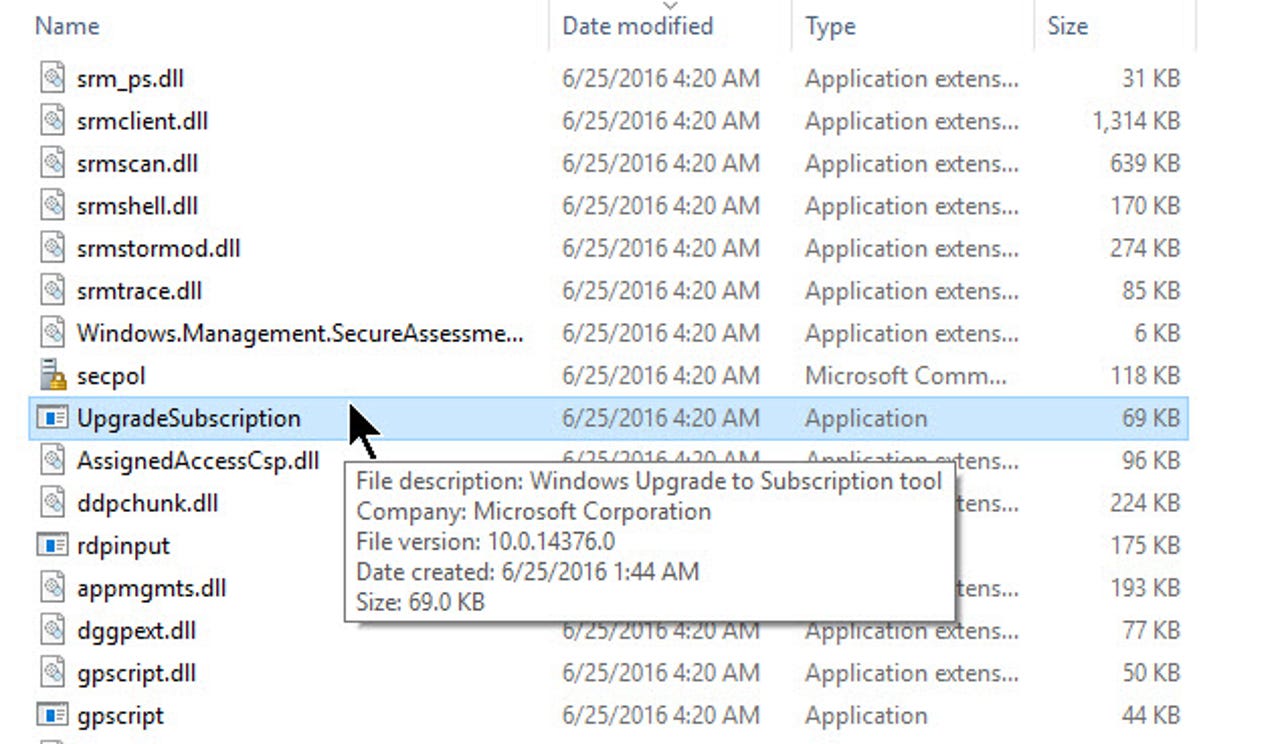Mystery file in preview build hints at Windows 10 subscriptions

The latest preview builds of Windows 10 include a small mystery.
Buried in the System32 folder of build 14376, alongside 590 other .exe files, is a file whose name is guaranteed to raise eyebrows: UpgradeSubscription.exe. That file has been part of other recent preview builds, but has managed to remain under the radar until now.
In the file's properties, it's described as the Windows Upgrade to Subscription Tool, and its date and time stamp corresponds to other administrative tools in the same build. See for yourself:

This mystery file is new in Windows 10 preview build 14376.
The presence of that file is certain to ignite speculation among conspiracy theorists who were convinced in the run-up to the initial release of Windows 10 that the year-long free upgrade offer would turn into some sort of paid subscription.
When I asked Microsoft about this file, I got this response:
The Windows Upgrade to Subscription tool, found in the latest Windows Insider builds, helps to manage certain volume licensing upgrades from Windows 10 Pro Anniversary Update to Windows 10 Enterprise. This binary file is not associated with the free consumer upgrade offering nor is it applicable to consumer Windows editions.
That seems to be a pretty firm denial, but when I pressed for additional details I got a polite but firm, "No further comment."
Running this mysterious tool does nothing, and inspecting the file itself seems to confirm that it's related to enterprise licensing, with one tantalizing reference to a registry value called AllowWindowsSubscription.
Poking around elsewhere in build 14376 turns up only a few references to servicing packages named Microsoft-Client-License-Platform-Upgrade-Subscription-Package.
I remain convinced, as I wrote earlier this year, that Windows 10 subscriptions aren't happening for consumer and small business versions. But something I wrote in that post bears repeating here:
[L]arge enterprises, including corporate customers and government agencies, actually have been paying for Windows subscriptions for many years, thanks to a volume licensing program called Software Assurance. That annual fee gives them a slew of enterprise features and usage rights that consumers and small businesses don't need and certainly won't pay for.
The trouble with Microsoft's Volume Licensing program is that it's devilishly complicated and pretty much out of reach of smaller companies that could benefit from the features in Windows Enterprise edition but don't have the expertise or the size to justify an Enterprise Agreement.
In fact, I suspect that this option might not be new after all. Several years ago, an early release of Intune, Microsoft's cloud-based management platform, included an add-on upgrade license for Windows Enterprise edition for an additional monthly subscription fee of $5 on top of the $6 cost of the Intune license.
Most of the information related to the product has vanished from Microsoft's website, but I did find one archived PDF file from 2012 that confirms those details:
The option for Windows subscriptions was available in 2012 but was retired in 2015.
In support forums early last year, Microsoft confirmed that the option to purchase an Intune subscription with the Windows 8.1 Enterprise OS has been "retired," and the alternative is an Enterprise Agreement, only suitable for companies with 250 or more employees.
In another document from late 2012, I found this description of the Microsoft Online Subscription Program (MOSP):
The Microsoft Online Subscription Program (MOSP) is a subscription-based Microsoft Volume Licensing program for organizations with five or more users that want to subscribe to, activate, provision, and maintain services seamlessly and affordably. MOSP is very flexible and is ideal for any type of organization that wants to add online services to its portfolio.
Most of the products on that list are firmly established subscription offerings now: Office 365, the Azure platform, and Microsoft Dynamics CRM Online. The Windows Enterprise offering as part of the Intune management suite probably seemed like a good idea at the time. But since then, Intune has become more focused on mobile device management, and that role isn't really a good fit with Windows desktop licensing.
There's clearly a market for a subscription upgrade that gives small companies access to Enterprise features. But for now, at least, we'll have to wait for an official announcement (or more leaks) about what this mysterious file is for.
I suspect we'll know before August 2.